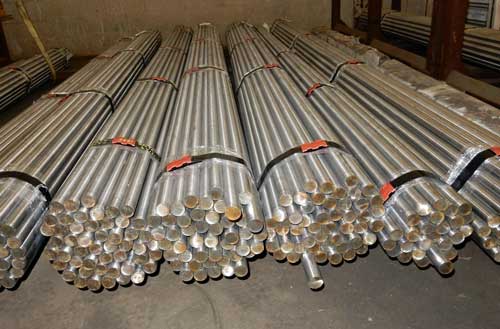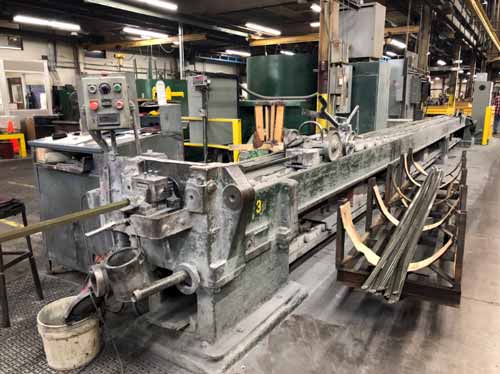The Industry Leader of Precision
Cold Rolled & Cold Drawn Metal Profiles
Home » What We Do » Custom Cold Drawing
The Industry Leader of Precision
Cold Rolled & Cold Drawn Metal Profiles
Home » What We Do » Custom Cold Drawing
Rathbone Precision Metals, founded in 1905, specializes in cold drawing custom profiles in a wide range of metals, including high- and low-carbon steels, free-cutting alloys, 300 and 400 series stainless steel, and precipitation hardened stainless steel. Our customers span a variety of sectors, including power generation, medical, gas and oil, firearm, hand tools, and lawn and garden markets. We take quality very seriously, as an ISO certified and accredited manufacturer.


Cold drawn steel demonstrates a number of characteristics that are advantageous to many industries and applications, such as:

| S/O | Value | |
|---|---|---|
| Size/Cross Section | Standard Optional | Typical Range of .032" to 2" Profile Dependent |
| Linear Tolerance | Standard Optional | ±0.002"* ±0.0005"* |
| Radial Tolerance | Standard Optional | Small Radii: ±0.005"* Large Radii: ±0.010"* ±0.002"* |
| Corner/Fillets | Standard Optional | Up to 90°: 0.015" R max Obtuse: blend of angle intersection Up to 90°: 0.005" R max Obtuse: Profile Dependent |
| Surface Finish | Standard Optional | 125 Ra 40 Ra |
| Straightness | Standard Optional | ±0.020"* / Foot Cumulative ±0.005"* Cumulative |
| Twist | Standard Optional | ± 2° per foot Profile Dependent |
| Temper | Standard Optional | As Cold Drawn Stress Relieved, Annealed or Heat Treated (OSP) |
| Decarburization | Standard Optional | See Optional 0.005" max total and or partial Requires Surface Improved starting raw stock |
| Lengths | Standard Optional | Coil: Max Weight Bar: Random Mill Lengths (RML 7' - 14') Bar: Specific Lengths Pieces: Specified Length (tolerances of ±0.005") |
| Packaging | Standard Optional | Bar: Reddi-Crate™ Coil: VCI wrapped Pieces: VCI Bag in cardboard box Bar: Banded Bundles, Wood Crate or Custom Coil: Spool, Wood Box, Drum or Custom Pieces: Wood Box or Custom |
| Testing Abilities | Standard Optional | Rathbone has several means of QA control - Call for details Outside Testing Service |
| Cutting Options | Standard Optional | Shear / Pinch or Saw Cut (Shape Dependent) Shaped Shear or Precision Cutting (Shape Dependent) |
| Approx. Hardness Range | Standard Optional | Carbon: HRB 75 to HRB 95 Alloy: HRB 90 to HRC 28 Stainless: HRB 90 to HRC 25 Hardness may be able to be adjusted by modification of the cold work process |
| Value | |
|---|---|
| Size/Cross Section | Standard: Typical Range of .032" to 2" Optional: Profile Dependent |
| Linear Tolerance | Standard: ±0.002"* Optional: ±0.0005"* |
| Radial Tolerance | Standard: Small Radii: ±0.005"* Large Radii: ±0.010"* Optional: ±0.002"* |
| Corner/Fillets | Standard: Up to 90°: 0.015" R max Obtuse: blend of angle intersection Optional: Up to 90°: 0.005" R max Obtuse: Profile Dependent |
| Surface Finish | Standard: 125 Ra Optional: 40 Ra |
| Straightness | Standard: ±0.020"* / Foot Cumulative Optional: ±0.005"* Cumulative |
| Twist | Standard: ± 2° per foot Optional: Profile Dependent |
| Temper | Standard: As Cold Drawn Optional: Stress Relieved, Annealed or Heat Treated (OSP) |
| Decarburization | Standard: See Optional 0.005" max total and or partial Optional: Requires Surface Improved starting raw stock |
| Lengths | Standard: Coil: Max Weight Bar: Random Mill Lengths (RML 7' - 14') Optional: Bar: Specific Lengths Pieces: Specified Length (tolerances of ±0.005") |
| Packaging | Standard: Bar: Reddi-Crate™ Coil: VCI wrapped Pieces: VCI Bag in cardboard box Optional: Bar: Banded Bundles, Wood Crate or Custom Coil: Spool, Wood Box, Drum or Custom Pieces: Wood Box or Custom |
| Testing Abilities | Standard: Rathbone has several means of QA control - Call for details Optional: Outside Testing Service |
| Cutting Options | Standard: Shear / Pinch or Saw Cut (Shape Dependent) Optional: Shaped Shear or Precision Cutting (Shape Dependent) |
| Approx. Hardness Range | Standard: Carbon: HRB 75 to HRB 95 Alloy: HRB 90 to HRC 28 Stainless: HRB 90 to HRC 25 Optional: Hardness may be able to be adjusted by modification of the cold work process |